Rafts And Canoes
Rafts, as we have already remarked, must undoubtedly have been the beginning of navigation. But they have not, like many other species of ancient craft, been altogether superseded by modern inventions. True, we do not nowadays carry
on war on rafts, but we still carry on trade with them in many parts of the world. How the rafts of ancient times were formed we cannot tell precisely, though we can easily guess; but one thing we know, and that is, that the first improvement made in such craft was the thrusting of a few thick planks down into the water, to the depth of three or four feet, between the logs which composed the raft. These acted the part of a keel, and, by pressing against the water side-ways when a side wind blew, prevented the raft from making much of what is called leeway—that is, drifting in the direction in which the wind happened to be blowing. Some sorts of Dutch vessels use lee-boards for this purpose at the present time.
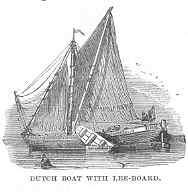
The rafts now in use on the great rivers of America are exceedingly curious in many respects. One peculiarity of many of them is that they float themselves, not goods, to market—the pine logs of which they are constructed being the marketable commodity. Some of these “lumber-rafts,” as they are called, are of great size; and as their navigators have often to spend many weeks on them, slowly floating down the rivers, they build huts or little cottages on them, cook their provisions on board, and, in short, spend night and day in their temporary floating-homes as comfortably as if they were on the land.
When these rafts approach a waterfall or a rapid, they unfasten the lashings and allow several logs tied together to run down at a time. After the rapid is passed, the loose logs are collected together, the raft is reconstructed, and the voyage down to the sea continued. Of course, huts are built only on rafts which navigate the largest rivers, and are not thus liable to be taken to pieces.
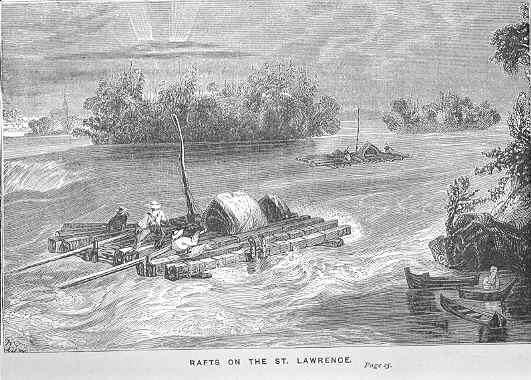
When the logs reach the sea, they are shipped to various parts of the world where timber is scarce. Large quantities are imported into Great Britain from Canada and other parts of America.
A bold thing has occasionally been done. Instead of shipping the logs in vessels, enterprising and ingenious men built them into a solid ship, leaving a small space to serve as a cabin and a hold for provisions; then, erecting masts, they hoisted sail, and in this singular craft crossed the Atlantic. On arriving at port they broke up their raft-ship and sold it.
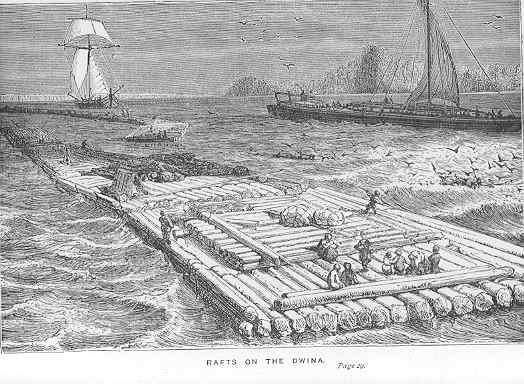
The immense size of the rafts which are floated down some of the great rivers of the world may be gathered from the following engraving, which represents a raft on the Dwina, one of the great rivers of Russia.
Rafts, however, have not been confined to the purposes of traffic. They have frequently been the means of saving the lives of shipwrecked mariners; but too often they have been the means only of prolonging the wretched existence of those who have ultimately perished at sea.
Turning now from the consideration of rafts, we shall describe canoes.
Canoes must, we think, have been invented after rafts. They were formed, as we have said, out of logs, of bark and of skins stretched upon frames of wood. Of ancient canoes we can say little. But it is probable that they were similar in most respects to the canoes used by savage nations at the present time; for man, in his lowest or most savage condition, is necessarily the same now that he was in ancient times. We shall, therefore, take a glance at the canoes of savage nations now existing, and thus shall form a good idea, we doubt not, of what canoes were in days of old.
Simplest among them all, perhaps, are the canoes of the North American Indians. 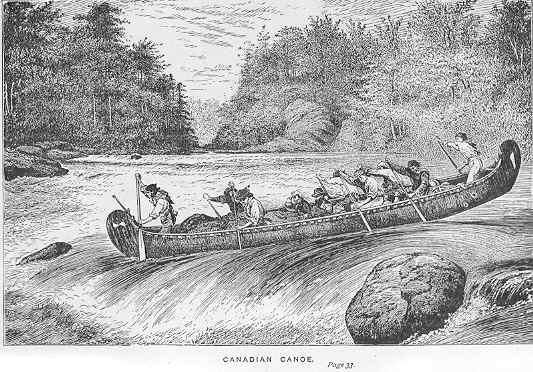 These are built of thin laths and ribs of wood, and are covered with the bark of the birch-tree. The sheets of bark are not a quarter of an inch thick. Several sheets are used in the covering of one canoe. They are sewed together with the long pliant roots of the pine, and the seams are rendered tight with gum procured from the same tree. So light are these canoes, that two men can carry on their shoulders one capable of holding eight or ten men, with their provisions, etcetera, for a voyage of many months. They are of various sizes—from the hunting canoe which holds one Indian, to the largest canoe that carries fourteen. They are propelled by short paddles instead of oars.
These are built of thin laths and ribs of wood, and are covered with the bark of the birch-tree. The sheets of bark are not a quarter of an inch thick. Several sheets are used in the covering of one canoe. They are sewed together with the long pliant roots of the pine, and the seams are rendered tight with gum procured from the same tree. So light are these canoes, that two men can carry on their shoulders one capable of holding eight or ten men, with their provisions, etcetera, for a voyage of many months. They are of various sizes—from the hunting canoe which holds one Indian, to the largest canoe that carries fourteen. They are propelled by short paddles instead of oars.
Many and terrible are the risks run by voyageurs who travel through the lakes and rivers of North America in these canoes.
The following anecdote is related of a narrow escape made by some fur-traders while descending one of the rivers in the backwoods of the Hudson Bay Territory:— One fine evening in autumn, a north-canoe was gliding swiftly down one of the noble bends in the river referred to. New, beautiful, and ever-changing scenes were being constantly opened up to the view of the voyageurs, whose plaintive and beautiful canoe-songs were rolling over the waters. Suddenly the song ceased as the distant roar of a waterfall struck their ears, and the steersmen—for there are usually two, one in the bow and one in the stern—prepared to land and “make a portage,”—that is, carry the canoe and lading past the falls by land, and re-launch and re-load in the smooth water below.
The approach to the landing-place at the head of the fall was somewhat difficult, owing to a point of rock which projected into the stream in the direction of the fall, and round which point it was necessary to steer with some dexterity, in order to avoid being drawn into the strong current. The fearless guides, however, had often passed the place in former years in safety, and accordingly dashed at the point with reckless indifference, their paddles flinging a circle of spray over their heads as they changed from side to side with graceful but vigorous rapidity. The swift stream carried them quickly round the point of danger, and they had almost reached the quiet eddy near the landing-place when the stem of the canoe was caught by the current, which instantly whirled it out from the shore and carried it down stream like an arrow. Another moment, and the gushing water dragged them to the verge of the fall, which thundered and foamed among frightful chasms and rocks many feet below. It was the work of a moment. The stern of the canoe almost overhung the abyss, and the voyageurs plied their paddles with the desperation of men who felt that their lives depended on the exertions of the next awful minute. For a few seconds the canoe remained stationary, and seemed to tremble on the brink of destruction—the strength of the water and the power of the men being almost equally balanced—then, inch by inch, it began slowly to ascend the stream. The danger was past! A few nervous strokes, and the canoe shot out of the current like an arrow, and floated in safety in the still water below the point.
The whole thing, from beginning to end, occurred in a few seconds; but who can describe or comprehend the tumultuous gush of feeling aroused during those brief moments in the bosoms of the voyageurs? The sudden, electric change from tranquil safety to the verge of what appeared certain destruction—and then, deliverance! It was one of those thrilling incidents which frequently occur to those who thread the wildernesses of this world, and is little thought of by them beyond the moment of danger; yet it was one of those solemn seasons, more or less numerous in the history of all men, when the Almighty speaks to his careless creatures in a voice that cannot be mistaken, however much it may be slighted; awakening them, with a rough grasp, to behold the slender cord that suspends them over the abyss of eternity.
The canoes used by the Eskimos who inhabit the Polar Regions are made of a light framework of wood, which is covered entirely over with seal-skin—a round hole being left in the centre, in which the Eskimo sits. Round this hole there is a loose piece of skin, which is drawn up by the man and fastened round his waist. The machine is thus completely water-tight. No waves can dash into, although they can sweep over it; and if by chance it should upset, the Eskimo can turn it and himself up into the proper position by one dexterous sweep of his long, double-bladed paddle. The paddle, which varies from ten to fifteen feet, is simply a pole with a blade at each end. It is grasped in the centre, and each end dipped alternately on either side of the kayak, as this canoe is called. Eskimo kayaks are first-rate sea-boats. They can face almost any sort of weather. They are extremely light, and are propelled by the natives very swiftly. In these frail canoes the natives of the Polar Regions pursue seals and whales, and even venture to attack the walrus in his native element. The kayak is used exclusively by the men. The oomiak, or women’s canoe, is of much larger and clumsier construction, somewhat like a boat. It is open above, and can hold a large family of women and children. Like the kayak, it is a framework of wood covered with seal-skin, and is propelled by means of short paddles of the spoon form.
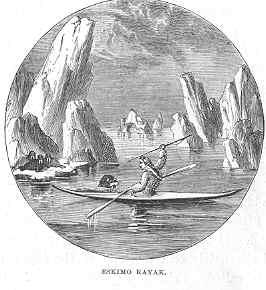
The famous “Rob Roy” canoe, which is now so much in vogue among boys and young men of aquatic tendency, is constructed and managed on precisely the same principles with the Eskimo kayak; the only difference between the two being that the “Rob Roy” canoe is made of thin wood instead of skin, and is altogether a more elegant vessel. An account of it will be found in our chapter on “Boats.” The South Sea islanders also use a canoe which they propel with a double-bladed paddle similar to that of the Eskimos. They are wonderfully expert and fearless in the management of this canoe, as may be seen from the annexed woodcut.
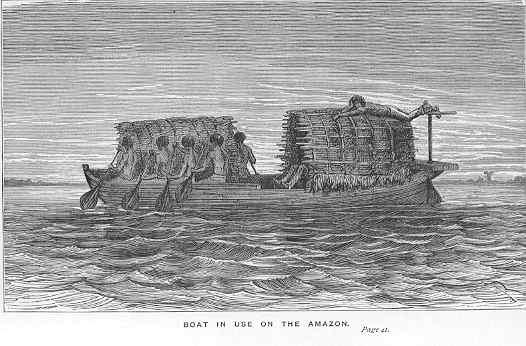
In order to show that the paddle of the canoe is more natural to man than the oar, we present a picture of the canoe used by the Indians of the Amazon in South America. Here we see thar the savages of the south, like their brethren of the north, sit with their faces to the bow and urge their bark forward by neans of short paddles, without using the gunwale as a fulcrum. The oar is decidedly a more modern and a more scientific instrument than the paddle, but the latter is better suited to some kinds of navigation than the former.
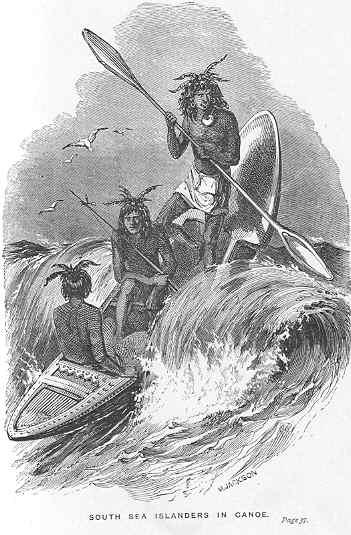
Very different indeed from the light canoes just described are the canoes of the South Sea islanders. Some are large, and some are small; some long, some short; a few elegant, a few clumsy; and one or two peculiarly remarkable. Most of them are narrow, and liable to upset; in order to prevent which catastrophe the natives have ingeniously, though clumsily, contrived a sort of “outrigger,” or plank, which they attach to the side of the canoe to keep it upright. They also fasten two canoes together to steady them.
One of these double canoes is thus described by Cheever in his “Island World of the Pacific:”—“A double canoe is composed of two single ones of the same size placed parallel to each other, three or four feet apart, and secured in their places by four or five pieces of wood, curved just in the shape of a bit-stock. These are lashed to both canoes with the strongest cinet, made of cocoa-nut fibre, so as to make the two almost as much one as same of the double ferry-boats that ply between Brooklyn and New York. A flattened arch is thus made by the bow-like cross-pieces over the space between the canoes, upon which a board or a couple of stout poles laid lengthwise constitute an elevated platform for passengers and freight, while those who paddle and steer sit in the bodies of the canoes at the sides. A slender mast, which may be unstepped in a minute, rises from about the centre of this platform, to give support to a very simple sail, now universally made of white cotton cloth, but formerly of mats.”
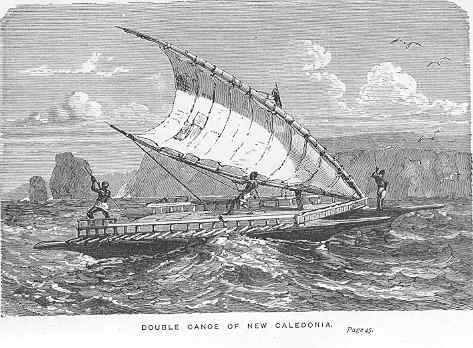
The double canoes belonging to the chiefs of the South Sea islanders are the largest,—some of them being nearly seventy feet long, yet they are each only about two feet wide and three or four feet deep. The sterns are remarkably high—fifteen or eighteen feet above the water.
The war canoes are also large and compactly built; the stern being low and covered, so as to afford shelter from stones and darts. A rude imitation of a head or some grotesque figure is usually carved on the stern; while the stem is elevated, curved like the neck of a swan, and terminates frequently in the carved figure of a bird’s head. These canoes are capable of holding fifty warriors. Captain Cook describes some as being one hundred and eight feet long. All of them, whether single or double, mercantile or war canoes, are propelled by paddles, the men sitting with their faces in the direction in which they are going.
As may be supposed, these canoes are often upset in rough weather; but as the South Sea islanders are expert swimmers, they generally manage to right their canoes and scramble into them again. Their only fear on such occasions is being attacked by sharks. Ellis, in his interesting book, “Polynesian Researches,” relates an instance of this kind of attack which was made upon a number of chiefs and people—about thirty-two—who were passing from one island to another in a large double canoe:— “They were overtaken by a tempest, the violence of which tore their canoes from the horizontal spars by which they were united. It was in vain for them to endeavour to place them upright again, or to empty out the water, for they could not prevent their incessant overturning. As their only resource, they collected the scattered spars and boards, and constructed a raft, on which they hoped they might drift to land. The weight of the whole number who were collected on the raft was so great as to sink it so far below the surface that they stood above their knees in water. They made very little progress, and soon became exhausted by fatigue and hunger. In this condition they were attacked by a number of sharks. Destitute of a knife or any other weapon of defence, they fell an easy prey to these rapacious monsters. One after another was seized and devoured, or carried away by them, and the survivors, who with dreadful anguish beheld their companions thus destroyed, saw the number of their assailants apparently increasing, as each body was carried off until only two or three remained.
“The raft, thus lightened of its load, rose to the surface of the water, and placed them beyond the reach of the voracious jaws of their relentless destroyers. The tide and current soon carried them to the shore, where they landed to tell the melancholy fate of their fellow-voyagers.”
Captain Cook refers to the canoes of New Zealand thus:—
“The ingenuity of these people appears in nothing more than in their canoes. They are long and narrow, and in shape very much resemble a New England whale-boat. The larger sort seem to be built chiefly for war, and will carry from forty to eighty or a hundred armed men. We measured one which lay ashore at Tolaga; she was sixty-eight and a half feet long, five feet broad, and three and a half feet deep. The bottom was sharp, with straight sides like a wedge, and consisted of three lengths, hollowed out to about two inches, or one inch and a half thick, and well fastened together with strong plaiting. Each side consisted of one entire plank, sixty-three feet long, ten or twelve inches broad, and about one inch and a quarter thick; and these were fitted and lashed to the bottom part with great dexterity and strength.
“A considerable number of thwarts were laid from gunwale to gunwale, to which they were securely lashed on each side, as a strengthening to the boat. The ornament at the head projected five or six feet beyond the body, and was about four and a half feet high. The ornament at the stern was fixed upon that end as the stern-post of a ship is upon her keel, and was about fourteen feet high, two broad, and one inch and a half thick. They both consisted of boards of carved work, of which the design was much better than the execution. All their canoes, except a few at Opoorage or Mercury Bay, which were of one piece, and hollowed by fire, are built after this plan, and few are less than twenty feet long. Some of the smaller sort have outriggers; and sometimes two are joined together, but this is not common.
“The carving upon the stern and head ornaments of the inferior boats, which seemed to be intended wholly for fishing, consists of the figure of a man, with the face as ugly as can be conceived, and a monstrous tongue thrust out of the mouth, with the white shells of sea-ears stuck in for eyes. But the canoes of the superior kind, which seem to be their men-of-war, are magnificently adorned with openwork, and covered with loose fringes of black feathers, which had a most elegant appearance. The gunwale boards were also frequently carved in a grotesque taste, and adorned with tufts of white feathers placed upon black ground. The paddles are small and neatly made. The blade is of an oval shape, or rather of a shape resembling a large leaf, pointed at the bottom, broadest in the middle, and gradually losing itself in the shaft, the whole length being about six feet. By the help of these oars they push on their boats with amazing velocity.”
Mr Ellis, to whose book reference has already been made, and who visited the South Sea Islands nearly half a century later than Cook, tells us that the single canoes used by some of the islanders are far safer than the double canoes for long voyages, as the latter are apt to be torn asunder during a storm, and then they cannot be prevented from constantly upsetting.
Single canoes are not so easily separated from their outrigger. Nevertheless they are sometimes upset in rough seas; but the natives don’t much mind this. When a canoe is upset and fills, the natives, who learn to swim like ducks almost as soon as they can walk, seize hold of one end of the canoe, which they press down so as to elevate the other end above the sea, by which means a great part of the water runs out; they then suddenly loose their hold, and the canoe falls back on the water, emptied in some degree of its contents. Swimming along by the side of it, they bale out the rest, and climbing into it, pursue their voyage.
Europeans, however, are not so indifferent to being overturned as are the savages. On one occasion Mr Ellis, accompanied by three ladies, Mrs Orsmond, Mrs Barff, and his wife, with her two children and one or two natives, were crossing a harbour in the island of Huahine. A female servant was sitting in the forepart of the canoe with Mr Ellis’s little girl in her arms. His infant boy was at its mother’s breast; and a native, with a long light pole, was paddling or pushing the canoe along, when a small buhoe, with a native youth sitting in it, darted out from behind a bush that hung over the water, and before they could turn or the youth could stop his canoe, it ran across the outrigger. This in an instant went down, the canoe was turned bottom upwards, and the whole party precipitated into the sea.
The sun had set soon after they started from the opposite side, and the twilight being very short, the shades of evening had already thickened round them, which prevented the natives on shore from seeing their situation. The native woman, being quite at home in the water, held the little girl up with one hand, and swam with the other towards the shore, aiding at the same time Mrs Orsmond, who had caught hold of her long hair, which floated on the water behind her. Mrs Barff, on rising to the surface, caught hold of the outrigger of the canoe that had occasioned the disaster, and calling out loudly for help, informed the people on shore of their danger, and speedily brought them to their assistance. Mrs Orsmond’s husband, happening to be at hand at the time, rushed down to the beach and plunged at once into the water. His wife, on seeing him, quitted her, hold of the native woman, and grasping her husband, would certainly have drowned both him and herself had not the natives sprung in and rescued them.
Mahinevahine, the queen of the island, leaped into the sea and rescued Mrs Barff; Mr Ellis caught hold of the canoe, and supported his wife and their infant until assistance came. Thus they were all saved.
The South Sea islanders, of whose canoes we have been writing, are—some of them at least—the fiercest savages on the face of the earth. They wear little or no clothing, and practise cannibalism—that is, man-eating—from choice. They actually prefer human flesh to any other. Of this we are informed on most unquestionable authority.
Doubtless the canoes which we have described are much the same now as they were a thousand years ago; so that, by visiting those parts of the earth where the natives are still savage, we may, as it were, leap backward into ancient times, and behold with our own eyes the state of marine architecture as it existed when our own forefathers were savages, and paddled about the Thames and the Clyde on logs, and rafts, and wicker-work canoes.
Previous: The Earliest Days Of Water-travelling
Next: Ancient Ships And Navigators
|
|
| SHARE | |
 |
|
| ADD TO EBOOK |






